KYIV, Ukraine — Nobody can agree on an acceptable peace in Ukraine. Should Russia be allowed to keep the lands it took by force? Should Ukraine be allowed to join NATO? What sort of security guarantee is sufficient? What sort is reasonable?
Deeper questions undergird these.
What sort of future is possible for Ukraine? And what is America’s interest in this war, which could be seen as another flare-up of ancient Slavic intramural fighting?
Petrovska, the current hot spot on Ukraine’s Western front, is 5,500 miles from Peoria, Illinois. NATO membership or some other U.S. security guarantee is a pledge that boys from Peoria will die for Petrovska. This is a tough sell to an American public that is tired after 80 years as the global policeman.
And would a ceasefire in this war really mean peace for Ukraine, as long as Russian President Vladimir Putin looms next door? It’s hard to imagine a less trustworthy neighbor. To make matters worse, many Ukrainians doubt that anything will get better after Putin.
All these questions point us toward uncomfortable answers. The United States and Ukraine are allies, but our interests are not identical.
There’s no panacea for the Eurasian steppe and the Black Sea. There’s no future where Ukraine lives safely and easily. But there is a future where Russia is more afraid to aggress on Ukraine, and this future does involve the U.S., and some lessons learned in this awful war.
‘We live. We pray. We work. But all at war’
Much of life in Kyiv is normal in 2025. On Sunday morning, the faithful gather at churches of all stripes: Orthodox, Roman Catholic, eastern Catholic, evangelical. At night, the streets thrum with revelers, date nights at a cafe, swanky outings at a seafood place on Volodymyrska Street, guys catching a drink at the corner Negroni bar.
After Mass on Sunday, at a small Ukrainian-Catholic Church called St. Nicolas, Father Ihor Onyshkevych puts it this way: “We live. We pray. We work. But all at war.”
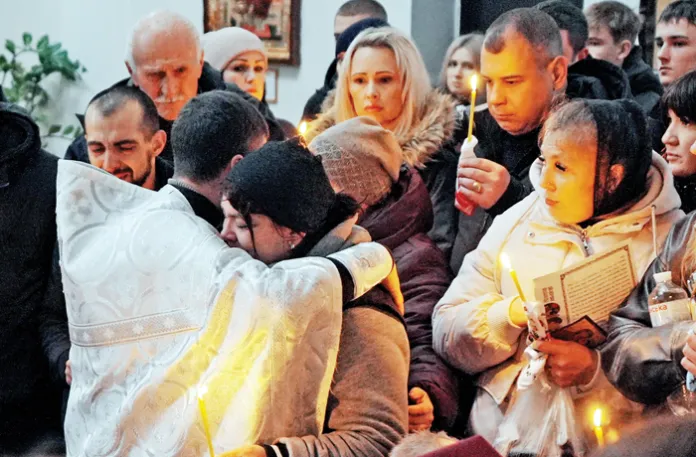
At first glance, you might not notice the differences between Kyiv and, say, Warsaw, Budapest, or Riga — the capitals of European countries not at war. But then you notice some details. It’s a bit dark: The string lights hanging over the streets are turned off, and Saint Volodymyr’s Cathedral is not lit up. Many of the street lights are off. This is mostly to conserve electricity in the wake of Russian attacks on power plants and the destruction of transformers, but it also reduces the targeting abilities of Russian drones.
Also, the gender ratios are off: Millions of men from their mid-20s to their mid-50s are missing. Hundreds of thousands are at war, many more fled the country, and many more are dead.
And if you live here, the weight of war weighs heavily.
Young men, who might otherwise be starting a career or a family, are conscripted and sent off to war. A 30-year-old father of two — his family’s breadwinner, his wife’s companion, and his children’s hero — is apt to be sent off to the front.
Ukrainians without generators might have no electricity most of the day, thanks to rationing and planned outages.
Anastasia, a 25-year-old mother of two, was at the Ocean Mall, which opened in 2024, with her husband and children. She told the story of her child’s open-heart surgery, which would be gut-wrenching for any mother. For Anastasia, it was far worse. She couldn’t be at the hospital, and during the operation, Russians launched a missile attack on the city. For hours, she had no idea whether the hospital was hit, whether her son was fine, or whether the surgery went well. Relaying this story at the mall’s food court one afternoon, she began crying.
The air raids are constant. Russia sends Iranian-made Shahed drones, flying kamikaze robots, into cities all over the country. While I was in Ukraine, dozens died in Ternopil, a city in western Ukraine, far from the front. Closer to Russia and the occupied territories, drone attacks and ballistic missile attacks are a part of life.
The attacks are getting more frequent and more damaging. Russia has modified the Shaheds, so they now bob and weave randomly, making them harder to intercept.
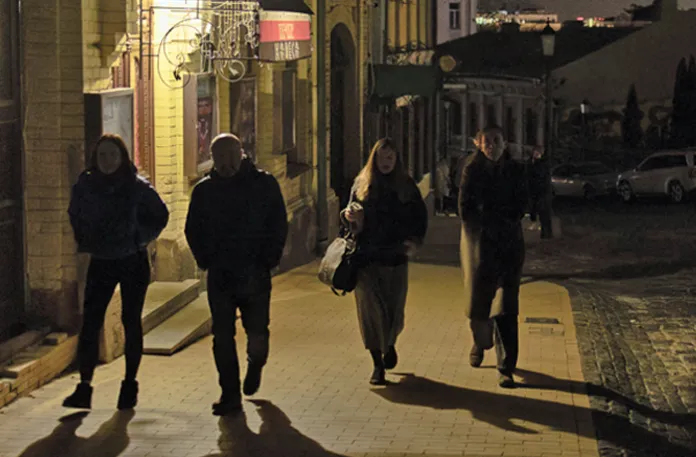
Residents face a choice: disrupt your life and sleep night after night by heading to the bomb shelter every time an alert goes off, or just hope you get lucky, and that the missile is intercepted or the drones hit someone else’s building.
Onyshkevych tells of a girl he knows whose family had to flee their hometown when occupied by the Russians. Now, in her new apartment in Kyiv, she doesn’t use her bedroom, but instead sleeps on a cot by the front door, so that she can get to the bomb shelter as quickly as possible.
And of course, part of war is death. “All my friends are dead,” one woman in her late 20s told me. She spent a couple of years as an army medic before coming back to Kyiv. Many mothers have lost multiple sons at the front.
On the front, things are no better. It’s basically a standstill. Ukraine has not taken back any territory in weeks, and it is slowly losing ground to Russia.
Kyiv relies on a Soviet-created centralized heating system, which makes it vulnerable to Russian drone or missile strikes. The average low temperature in Kyiv in February is below zero. If the Russian strikes continue, Ukrainians will be in for a long, cold, dark winter.
This is a people ready for the war to end.
‘We don’t want to win. We want peace’
Konstantin, who lives in Kyiv, jokes that he’s grateful to Putin. “If he didn’t invade Donetsk in 2014, my Katrina would not have left and come to Kyiv,” he says, putting his arm around his wife.
He stops himself to clarify, across the language divide, that this is a joke — that this war is utterly terrible. It’s terrible, and he just wants it over.
“We don’t want to win,” he says. “We want peace.”
The night before, on the streets of Kyiv, I run into a man in his 30s named Taras — “Like the poet,” he says, when I ask for the spelling — and ask him his vision for Ukrainian victory. Taras rejects the premise.
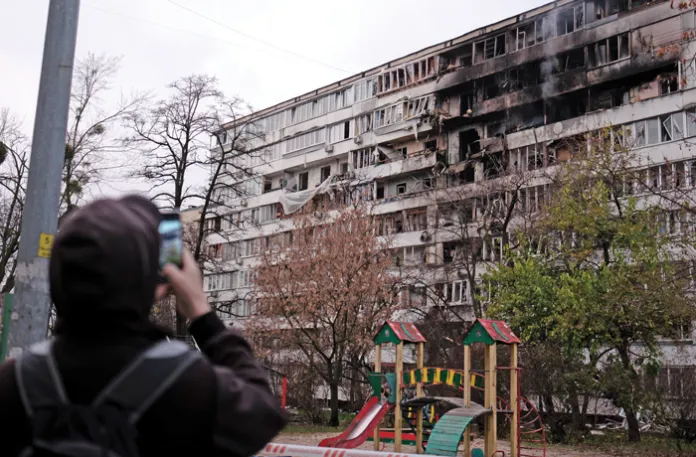
“I want to stop this war. I don’t want to win. I don’t want to lose. I want to stop.”
He’s of fighting age, so I ask Taras why he isn’t in the army. “I don’t want to give my life for the people who sit there,” he said, pointing toward Bankova, the hill where Ukrainian President Volodymyr Zelensky’s government sits. “I don’t trust them.”
The Zelensky administration has been roiled by corruption scandals. This dampens the patriotism of a man named after Taras Shevchenko, the national bard. “This war will continue a lot of years without any result. Some people want to stop this war, while some people want this war to continue,” then he names “military folks sitting in Kyiv. … They don’t want war to end.”
At the Negroni bar on Yaroslaviv Street, I ask Maksym, 22, about his vision of victory or peace: “Returning lost territories is good, but human life is more precious than beloved lands.”
Others, with more attachment to the occupied regions, are more hawkish and less ready to settle with Putin.
“Russia has to lose,” says Andriy, a 58-year-old eating lunch in the Ocean Mall food court. “Either Putin has to collapse or something else.”
Mark Sergeev was the pastor of a megachurch in Mariupol, which Russia bombed into rubble. Then, in November, a Russian missile destroyed his home outside of Kyiv. “Everybody’s asking me what the victory looks like, or end of the war. For Mariupol people, it’s coming back to Mariupol.”
Lisa is a young woman from the Kherson region. Russians flooded her town of Oleshky when they demolished the Kakhovka Dam. Although Ukraine took back Kherson, her village is still held by the Russians. “My father lives there to this day, and he is waiting for the Ukrainian armed forces to come and liberate him,” she says. “I cannot wait to go home.”
Freezing the lines where they are means telling Lisa and her father that nobody is coming to liberate Oleshky. They must accept disappointment and permanent dislocation.
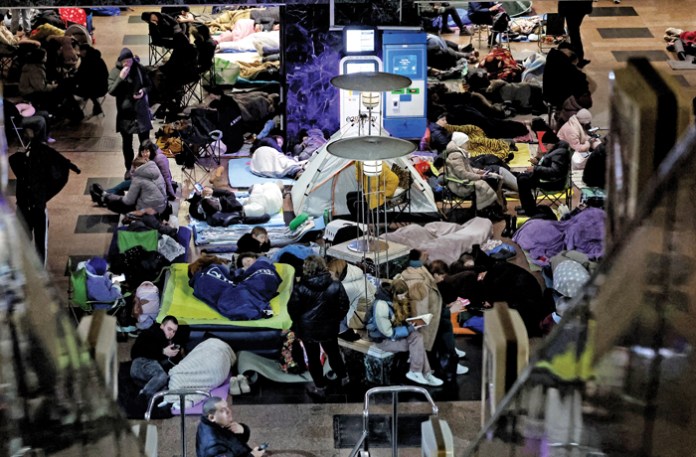
Children are a casualty of Russian occupation in many ways. Hundreds of Ukrainian children have been killed in the war, Zelensky says, and hundreds or thousands more have been, essentially, kidnapped by Russia. Many Ukrainian families remain in Russian-occupied territories, where the education system is dedicated to “turning Ukrainian children into Russian children and Russian soldiers,” according to Alina Dmytrenko, who works at a nonprofit organization called Save Ukraine.
It’s hard to stomach indefinite Russian control of Donetsk when that means consigning Ukrainian children to this fate.
Artem is a retired soldier who now builds software and hardware for drones. He’s in no mood for peace or territorial concessions. “We need to push them back to the border.”
Artem looks at his wounded knee and looks around his drone shop. “I’ve been in this for 10 years.” Then he looks at the American journalists before him. “I’ve buried more friends than some of you have. I’ve got my scores to settle.”
Terms of peace
This is the debate today: What scores should Ukraine settle? Should the Ukrainians really quit fighting before they take back their stolen land? What does it say to the rest of the world if Putin is rewarded with territory for his crime of invading his neighbor and siccing drones on their cities?
Reluctantly, the Ukrainian public and its ruling class seem to be limping toward a trade-off: They will cede de facto control of these Russian-occupied territories in exchange for a ceasefire from Russia and a security guarantee from the West.
Among the complicating factors, Ukrainians are skeptical of any American security guarantee.
One reason: The U.S. reneged on the 1993 Budapest agreement, in which we cajoled Ukraine into giving up its nuclear weapons with the promise we would defend them from any invasion.
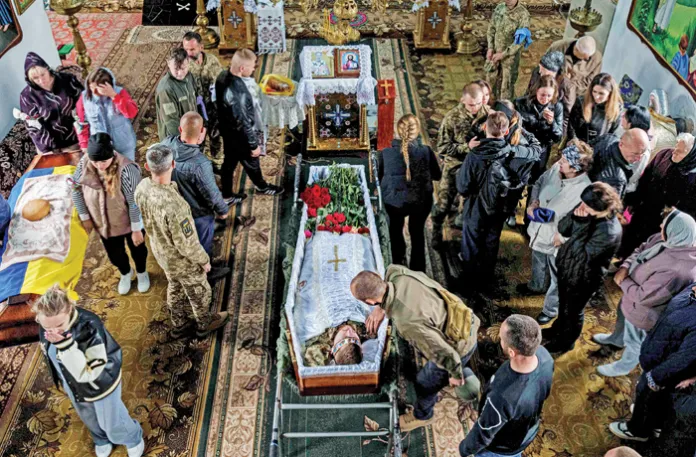
But also, Ukrainians simply don’t trust Putin. If he signs a ceasefire today, they imagine, that just buys him time to build back up his military and attack again in a year or two, or 10.
“The regime has to fall,” Sergeev insists. “Even if ceasefire going to happen, even if Trump do something, three years later, Trump will not be president, they going to go do this again.”
That’s why Artem says, “We need to think of something to make Russia never think of doing this again.”
“Never believe Russians,” says Natalia Chernyshova, a city official in Dnipro, in the Eastern half of Ukraine. “They always lie.”
This attitude is common, and it reveals a deeper problem. What plagues Ukraine is more fundamental: It shares a border with Russia. And Russia, many Ukrainians say, doesn’t merely want Crimea and some Western provinces. It wants Kyiv.
“The conflict is existential,” Soviet dissident Myroslav Marynovich says over lunch in Kyiv, objecting to President Donald Trump’s 28-point plan. “The West perceives this conflict as the conflict between two Slavonic nations: ‘They have some Western territory, so they have to sit down and to make a compromise, and there will be peace.’ No!” he exclaims. “This conflict is existential. For Putin, there is no Ukrainian nation, and Ukraine is part of Russia.”
“If the regime will not fall in Russia, nothing will change,” Sergeev says as he looks over the rubble of his destroyed home in the suburbs of Kyiv.
Security in Ukraine requires regime change in Moscow, the more hawkish Ukrainians argue.
Marynovich, like many Ukrainian hard-liners, talks of war crimes prosecutions. Zelensky has called for putting Putin in the dock in The Hague. This, of course, would require not a ceasefire and a peace deal, but an outright military defeat of Russia, as we defeated Nazi Germany and Imperial Japan.
He notes that Europe and the U.S. are nervous about a regime change war in Russia. Removing Putin would mean “dismembering the Russian Empire, and it means refugees, nuclear button in what hands, and so on, so on. So don’t even speak” of removing Putin.
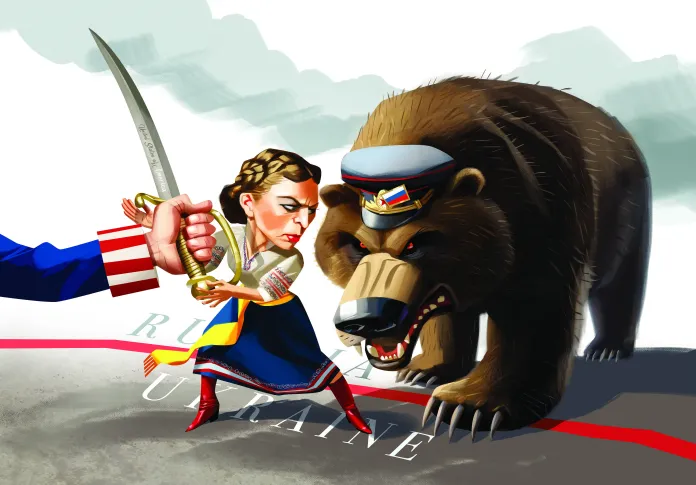
But even regime change wouldn’t do the trick, the hard-liners argue. Putin is a symptom of Russian society, many Ukrainians argue. Russia is inherently imperialistic, and the Russian empire, to be historically coherent, requires control of Kyiv.
“This is 104 million people living in crazy kind of propaganda spirit,” Sergeev says. “And I don’t know, only God can fix it. … It’s inside. I mean, it’s a spirit inside.
“So there is a perception in the Russian population that Ukraine … has to be a servant of Russia, not independent, but servant. And if Ukraine tries to be independent, they have to be punished.”
If Russia, by its nature, and not merely Putin, covets and resents Ukraine, then there is no possibility for peace. Ever. As long as Russia is its neighbor, Ukraine lives under the threat of attack.
Artem, who said “we need to think of something to make Russia never think of doing this again,” knows that won’t be easy. “We want Russia to stop existing as a world power.”
Instead, Marynovich says, in the West, “the idea is to balance — not to allow Ukraine to be defeated, not to allow Russia to be defeated. It is to make them all be exhausted from the war, and then peace agreement. This is the model for the rest. But it is not fair.”
Marynovich is correct. This isn’t fair. But foreign policy isn’t fair.
In fairness, nobody should have to be Russia’s neighbor, but in reality, somebody has to be. Somebody has to live with the violent and untrustworthy nation next door that salves the suffering of its subjects with empty promises of restoring past imperial greatness.
Ukraine, the name, probably comes from old Slavic words meaning “the borderlands.” In general, Slavs — Poles, Russians, Croatians, Ukrainians, etc. — see the ancient history of a people as somewhat determinative. This beautiful country of courageous, independent, and kind people seems condemned by history to be a borderland between the democratic West and the imperialist Russia.
Americans should have compassion, even pity. But it’s not out of pity or compassion that Americans ought to help Ukraine. It’s out of self-interest.
Buffer states are a fact of life, and the U.S. should help those buffer states be as strong as possible. A well-armed, independent Ukraine is a check on Russia.
This has nothing to do with Bush-era messianic dreams of spreading democracy. It also doesn’t require nation-building or even a U.S. military presence over there. Ukraine already has, perhaps, the most impressive military in Europe. It just needs to scale.
Warriors on the borderlands
The Ocean Mall, which opened during this war, is a great reflection of Ukrainians’ ambitions to be more like America. It’s modeled after the malls that defined upwardly mobile middle-class America in the 1990s. But for all Ukraine’s efforts, especially since independence, to seem American, there are crucial but subtle differences.
Atop the U.S. Capitol stands the Statue of Freedom. She carries a shield, and her sword is sheathed. In New York Harbor, our Statue of Liberty holds aloft a torch.
Towering over Kyiv is the 335-foot-tall Motherland Statue. She holds her shield high, but her sword even higher. Ukrainians recently removed the hammer and sickle from her shield, and replaced it with the national coat of arms — another weapon, the trident.
The Ukrainian trident is a stylized symbol, and a stylish one: You’ll see it all over the Washington area these days. Today, some say its second meaning is a descending dove, evoking the Christian symbol of the Holy Spirit. But historically, Ukrainians have understood it as a descending falcon — a bird of prey swooping toward its target.
Kyiv’s patron saint is St. Michael the Archangel. The city’s flag shows this warrior angel wielding both sword and shield.
The Ukrainians are a fighting people, thanks be to God. For the West, these are the kind of people we want standing between us and Russia. The U.S. should be grateful for these fighting Slavs and, when possible, help make sure they are well armed as they stand as the guardians of the West.
American cash, Ukrainian arms
When American politicians try to defend U.S. aid to Ukraine, they often make an odd argument. “Over half of the money goes directly into the U.S. economy, supporting U.S. businesses and workers,” Rep. Jason Crow (D-CO) says. “The new equipment updates U.S. military stocks, and the old equipment goes to Ukraine.”
“Most of this money is making its way to the U.S. defense industry,” one liberal journalist notes.
Subsidizing the Kyiv branch of Lockheed Martin or Boeing is neither a solid argument for military aid nor the best vision for Ukraine’s future.
Ukraine has its own defense industry, and given the demands of war, it’s likely the most innovative defense industry in modern history. Artem, in Kyiv, is developing an unjammable transmission system for drones. The army’s 3rd Assault Brigade has a facility called the Killhouse, where reports from the front lines are used to modify the drones, aerial and ground-based, sent by domestic manufacturers. Some of those domestic manufacturers are near the front.
There’s likely more lethal innovation in a warehouse-factory outside of Dnipro than there is in a billion-dollar Pentagon contract. There just isn’t the scale.
That’s where the U.S. should come in. Our support for Ukraine’s war efforts — that is, our effort to strengthen the buffer state — doesn’t have to be foreign aid. And the funding also shouldn’t necessarily be investment, which would mean U.S. ownership.
The U.S. should be financing Ukraine’s weapons industry. We ought to make massive loans to these innovative businesses. Maybe, as with student loans, we waive the interest and defer the payments during the war. Let these companies get big. Let them compete. Help them push Russia back.
And then, as they repay the loans, we do business with them — we buy their drones and computer chips, and learn from their expertise in fighting modern warfare.
Instead of keeping Ukraine as a welfare case, let it be a business partner with the War Department. This might not please Lockheed or Boeing, and it would require procurement reform and a change of culture at the Pentagon. But the result would be a stronger Ukraine and a more lethal U.S. — both of which are in our interest.
PEACE AT WHAT PRICE? THREE GUIDELINES FOR A DEAL IN UKRAINE
The people of Ukraine desperately want and deserve peace. Hopefully, soon they can get that peace in the form of a ceasefire. It will never be a restful peace, as the Russian bear will always be just over the border.
But it could be a confident peace, if American dollars help Ukrainians make their excellent army a massive excellent army. And a well-armed Ukraine will mean more peace for the West.
Timothy P. Carney is the senior political columnist for the Washington Examiner.
